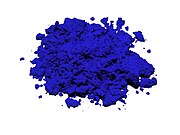International Klein Blue
From Wikipedia, the free encyclopedia
| International Klein Blue | ||
|---|---|---|
|
|
||
| Hex triplet | #002FA7 | |
| RGBB | (r, g, b) | (0, 47, 167) |
| HSV | (h, s, v) | (223°, 100%, 65%) |
| Source | [Unsourced] | |
| B: Normalized to [0–255] (byte) |
||
The International Klein Blue (IKB) is a deep blue hue first mixed by the French artist Yves Klein.
International Klein Blue (or IKB as it is known in art circles) was developed by French artist Yves Klein as part of his search for colors which best represented the concepts he wished to convey as an artist. Although Klein had worked with blue extensively in his earlier career, it was not until 1958 that he used it as the central component of a piece (the color effectively becoming the art). Klein embarked on a series of monochromatic works using IKB as the central theme. These included performance art where Klein painted models' naked bodies and had them walk, roll and sprawl upon blank canvases as well as more conventional single-color canvases.
The secret of IKB's remarkable visual impact comes from its heavy reliance on Ultramarine, as well as Klein's often thick and textured application of paint to canvas.
IKB was developed by Klein and chemists to have the same color brightness and intensity as dry pigments, which it achieves by suspending dry pigment in a clear synthetic resin. This new medium was patented by Klein.
International Klein Blue is outside the gamut of computer displays, and can therefore not be accurately portrayed on this page. However this photo of synthetic ultramarine pigment gives a fair impression of IKB as it appears in Klein's work.
[edit] International Klein Blue in human culture
- The architects Future Systems used IKB behind the spun aluminium disks on the exterior of Birmingham Selfridges.
|
|
|||||||||
|---|---|---|---|---|---|---|---|---|---|
| Air Force blue | Alice blue | Azure | Baby blue | Blue | Brandeis blue | Carolina blue | Cerulean | Cobalt blue | Columbia blue |
| Cornflower blue | Dark blue | Denim | Dodger blue | Duke blue | Egyptian blue | Electric blue | Han blue | Indigo | Intl. Klein blue |
| Light blue | Majorelle blue | Maya blue | Midnight blue | Navy blue | Periwinkle | Persian blue | Powder blue | Prussian blue | Royal blue |
| Sapphire | Sky blue | Steel blue | Ultramarine | Yale blue | |||||
| The samples shown above are representative only. | |||||||||


